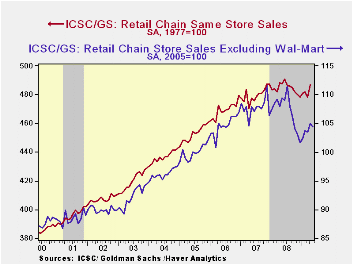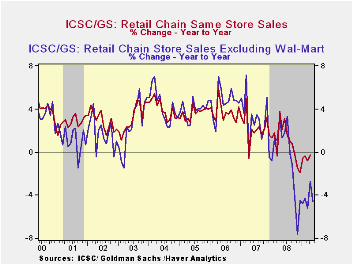 Global| Jun 19 2009
Global| Jun 19 2009U.S. Consumers' Quest For Value
by:Tom Moeller
|in:Economy in Brief
Summary
New figures available in Haver's SURVEYS database point up how chain store sales have been influenced this year by sales at Wal-Mart. The International Council of Shopping Centers (ICSC) along with Goldman Sachs produce monthly chain [...]

New figures available in Haver's SURVEYS database point up how chain store sales have been influenced this year by sales at Wal-Mart. The International Council of Shopping Centers (ICSC) along with Goldman Sachs produce monthly chain store sales figures with and without this big, value-priced retailer. Both data sets paint a picture of recovery in consumer spending; however, sales minus Wal-Mart have been less vibrant. Estimates suggest that Wal-Mart boosted sales growth by four percentage points or more during the depths of the recession. Before this recession began, the sales gains were more comparable to one another -- except in the 2001 recession, when a differential also opened up.
Wal-Mart does not currently report monthly sales along with the other retailers; instead, it reports just quarterly. Therefore, the monthly figures must be interpolated as they are by ICSC and are available only with a lag. These numbers show that from June to December, sales without Wal-Mart fell 6.8% but with Wal-Mart they were down a lesser 2.5%. The quest for value was acute. Now that consumer spending seems to be recovering from last year's slump, bargain hunting has become less intense. Sales excluding the retail giant rose 3.2% from January through April while sales with Wal-Mart rose a comparable 1.8%. Sales without Wal-Mart during May slipped 0.5% and Wal-Mart's sales will be available shortly.
The lesson clearly is that value matters a lot when times get tough. What sales patterns might we continue to see into the recovery? The historical evidence shows that the inroads made by Wal-Mart may be sustained, but that the growth differentials between sales with or without this big retailer will narrow. During the whole year following the recession of 2001, for instance, overall chain store sales rose by 2.3%, but without Wal-Mart they increased 1.8%.It will be useful to continue to watch both series for the fullest perspective of consumers' spending patterns.
Regardless of which chain store sales series is observed, consumer spending currently is under pressure. Gains in store sales are just moderate versus last year. Furniture & appliance store sales are lower though apparel store sales have risen slightly. The consumer spending prospects do, however, look brighter. Consumer confidence and consumer sentiment have been rising this year along with after-tax incomes due to recent tax cuts. Moreover, weakness in pricing power has enabled real after-tax incomes to grow this year at a 6.3% annual rate following their measly 1.3% gain during 2008. Even the job market has improved marginally as first time claims for unemployment insurance have fallen.
The chain store figures sighted above are comparable-store, or same-store, sales figures. As such they are similar to the weekly chain store sales values reported by ICSC/Goldman Sachs. These are available in Haver's SURVEYW database.
From 1996, this article from the Federal Reserve Bank of New York concludes that chain store sales can significantly improve the accuracy of predictions for several measures of consumer spending. It can be found here.
Oil prices and consumer spending from the Federal Reserve Bank of Richmond is available here.
| ICSC/Goldman Sachs Chain Store Sales (SA, 1977=100) | May | Y/Y | April | Y/Y | March | Y/Y | 2008 | 2007 | 2006 |
|---|---|---|---|---|---|---|---|---|---|
| Total | -- | -- | 486.9 | -0.3% | 478.0 | -0.8% | 1.0% | 2.3% | 3.7% |
| Excluding Wal-Mart | 104.4 | -4.6% | 104.9 | -2.8% | 103.5 | -5.2% | -0.6% | 3.0% | 4.7% |
Tom Moeller
AuthorMore in Author Profile »Prior to joining Haver Analytics in 2000, Mr. Moeller worked as the Economist at Chancellor Capital Management from 1985 to 1999. There, he developed comprehensive economic forecasts and interpreted economic data for equity and fixed income portfolio managers. Also at Chancellor, Mr. Moeller worked as an equity analyst and was responsible for researching and rating companies in the economically sensitive automobile and housing industries for investment in Chancellor’s equity portfolio. Prior to joining Chancellor, Mr. Moeller was an Economist at Citibank from 1979 to 1984. He also analyzed pricing behavior in the metals industry for the Council on Wage and Price Stability in Washington, D.C. In 1999, Mr. Moeller received the award for most accurate forecast from the Forecasters' Club of New York. From 1990 to 1992 he was President of the New York Association for Business Economists. Mr. Moeller earned an M.B.A. in Finance from Fordham University, where he graduated in 1987. He holds a Bachelor of Arts in Economics from George Washington University.






